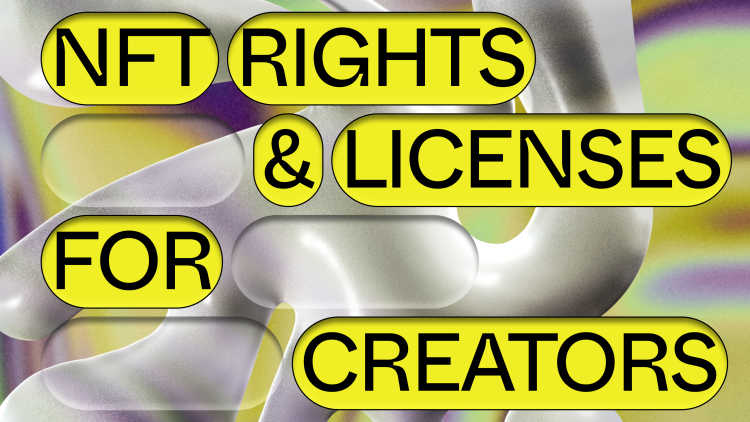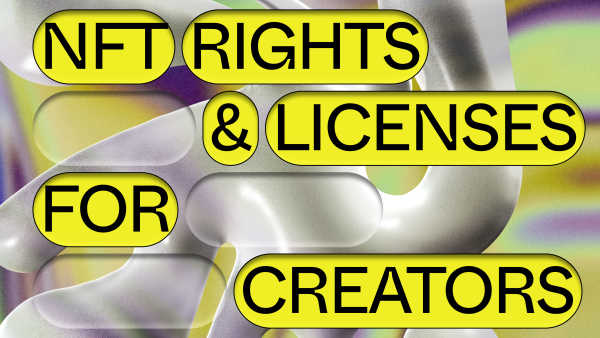Everything you need to know about NFT licensing.


Disclaimer: This article is not legal advice nor does it constitute financial advice. Always do your own research.
Well, turns out spending $116K on a JPEG doesn’t actually mean you own it. (⌒_⌒;)
Look, If you hold an NFT in your wallet, of course you own the NFT, but that doesn’t mean you own the art associated (linked) to the NFT. In fact, out of the top 25 projects currently listed on OpenSea, only one even attempts to give you legal ownership of the associated artwork. One. And it’s definitely not the Apes.
IP, CC0 & NFTs
The debate around how NFT collections handle IP rights is passionate, to say the least. Perhaps the most divisive hot take on the IP vs CC0 debate comes courtesy of nft42 founder J1mmy.eth who put it as “Capitalism v Communism”. But this is about more than monetization. Focusing only on the financial upside is shortsighted when considering the potential cultural impact.
Before we go there, though: let’s take a step back. Why is this even relevant?
The NFT Ownership Misconception
For better or worse, one of the core narratives contributing to the meteoric rise of NFTs is the assumption that owning an NFT gives you ownership of whatever is linked or associated with it. Though certainly a killer use case, it's far from the only one. Since NFTs CAN grant ownership rights, and sometimes DO, even if in limited fashion, the purpose or value of holding an NFT that DOESN’T grant IP rights gets confusing.
The recent okie-doke from the Moonbirds project, Tiffany’s creating Punks jewelry, & the BAYC/Ryder Ripps lawsuit have each brought different IP rights issues to light, forcing the wider community to reassess the very essence & value of their NFTs. Ultimately one central question remains on everyone's mind: who owns the art?
What Is IP? An Overview
IP Rights Defined
Intellectual Property is a catch-all term to describe property rights related to non-physical assets. There are four main types of Intellectual Property: Copyrights, Trademarks, Patents, & Trade Secrets. Given that Copyright is the primary legally recognized form of IP for digital content, we’ll focus our attention here. Note that whenever a project says you own the IP or have IP rights, Copyright is what they're usually referring to.
Understanding Copyrights
A copyright covers original works of authorship fixed in any tangible medium, such as a painting, a photograph, a film, or a video game. Copyright ownership grants the owner the ability to exercise certain exclusive rights & to authorize others to do the same. More specifically, it allows the copyright holder the right to reproduce, distribute, publicly display, perform the work and to create derivative works.
Thankfully, you don’t need to register to obtain a copyright for your works. It attaches once you create the work. However, registration may be necessary if you are required to enforce your rights in U.S. Federal Court. In the United States, copyright remains in effect for the life of the author + 70 years, or, for anonymous or corporate works, the lesser of 120 years from creation or 95 years from publication, at which point the work is entered into the public domain.
The IP Thesis: Control, Commercial Rights & Incentives
So, legal hurdles & constraints aside, what’s the beef between IP advocates & CC0 champions?
For those who wish unlimited, exclusive commercialization rights to be the standard for how NFT IP rights are handled, there’s an assumption that such rights directly incentivize holders to contribute productive, thoughtful or creative applications to the underlying property, since they hold exclusive rights to capture any value created in the process. This can be a powerful thing for collectors; facilitating licensing deals and talent agency representation.
Whether you plan to commercialize your NFT or not, this article by Galaxy.com puts it best, noting “Without copyright, a purchaser of digital content does not own that content, but instead “licenses” that content from the copyright holder, on terms dictated by the copyright holder. In this sense, the copyright holder (i.e., the licensor) is the digital content landlord; the purchaser (i.e., the licensee) of that content is the digital content tenant.”
Challenges With NFT Copyrights
Well, that seems pretty cut and dry, right? If a collection wants, can’t they just grant their holders IP rights? Not exactly.
Legal Transfer of Rights
Ensuring legal copyrights are transferred from the original author or artist to the projects’ creators, and then on to the holders themselves can be onerous. According to 17 U.S.C. § 204(a) of the Copyright Act, a valid transfer of copyright must be in writing and be signed by or on behalf of the transferring party.
While it's common for projects to make an announcement regarding IP rights in their Discord, or via Twitter, that may not be a legally binding or enforceable transfer. Historically, such a transfer is executed via “IP Assignment Agreement” (see Larva Labs transfer to Yuga Labs). Today, projects like Remaster.io are working on making this process more seamless.
Limited License Agreements
If we assume a legally binding full transfer of copyright ownership from the artist responsible for a collection’s art over to the creators or company behind the project, the project can now bestow full copyrights to the holders.
But…they probably won’t.
Instead, what most projects do is issue what’s known as a limited license. This limited license ensures that the collection retains full copyright ownership, thus affording them continued use of the associated art or other IP.
Though a finesse at first glance, there are some benefits to this limited approach. If as a holder, you want Yuga Labs or whatever project you’re involved in to keep building out the ecosystems surrounding the collection, they have to keep the rights. Otherwise, they would have to check with every holder before using their NFT’s artwork in ads, merch, or even to create models within a virtual world like *Otherside. *
Revocability
Another major shortcoming of limited licensing is its ability to be changed or modified unilaterally. Many terms of service have provisions allowing the grantor to change their terms without notice to their users. Unless a copyright is transferred in whole without limitations, the grantor can potentially change the terms of the permission, impacting a user’s downstream rights and exploitative opportunities. Though not common, it can happen. Just ask Moonbirds holders. If you happen to work a licensing deal allowing a brand or business to use the artwork associated with your NFT, but then YOUR rights are revoked, what does it mean for that deal?
Restricted Terms & Limitations
Even if a project claims to grant copyrights to you and never revokes those rights, its a best practice to pore through the terms of service to find out what rights are actually included. This due diligence is the only way to find out what sort of rights you have. Most projects tend to grant holders 1 of 4 types of limited licenses:
Commercial Rights
You can monetize the artwork freely—no cap on revenue, in any venue or format, for any length of time. (See Azuki.)
Limited Commercial Rights
You can monetize the artwork up to a certain amount of revenue, or in limited formats or venues, or for specified periods of time. Often, this license applies only to low-dollar sales ($100k limit) of merchandise (i.e., t-shirts). (See Doodles.)
Personal Use Only
You cannot monetize the artwork in any respect. You have limited display rights. (See VeeFriends)
Creative Commons -0 “No Rights Reserved”
The artwork is dedicated to the public domain. (see Moonbirds)
As of this moment, World of Women is the only collection within the top 25 NFT projects (based on implied market cap) that has explicitly stated their intent to assign full copyrights to their holders directly within a dedicated IP Assignment Agreement.
No matter how you slice it - this IP rights stuff can get messy. If only there was a simpler way!
Enter CC0.
What Is CC0? An Overview
CC0 Defined
CC0 is a type of licensing scheme that grants the same rights to users as if the work had been dedicated to the public domain. Essentially it means “no rights reserved” on intellectual property.
Unlike term bound, “don’t do this' ', “can’t do that” limited copyright licenses, CC0 licenses have zero restrictions & are irrevocable once granted. When a project goes CC0, there’s no going back. The finality of this license alone is a benefit.
The CC0 Thesis: Collective Ownership & Cultural Penetration
Given the challenges & complexities with limited copyrights, many deem CC0 as the simplest, most permissive license available. By “open sourcing” the artwork to allow anyone to use it as they see fit, be it for commercial use, derivative collections, or any other means - the dominant supporting thesis predicts that it's far easier for a project to gain significant cultural penetration.
Sherlock Holmes is often cited as demonstrating the power of public domain works, exploding in mindshare over the past 2 decades from multiple takes on the source material, including the BBC show & the Rober Downey Jr. films. Even El stopped the nose bleeds & remote viewing long enough to join in the investigative shenanigans! With so many distinct interpretations flooding the collective consciousness in such a short window of time, the brand has grown far more valuable & recognizable than would otherwise be the case. While a great example of what happens when an IP is widely leveraged for creative inspiration, technically, Holmes won't be a part of the public domain until later this decade.
Challenges With CC0 Licenses
No Infringement Protection
To be clear, you can still monetize works in the public domain, but you have no legal recourse to protect it from being copied or infringed - unless you make an additional contribution to the work. Just as with the Sherlock example, plenty of people successfully implement or leverage CC0 works within their commercial venture. Nevertheless, it's safe to assume most savvy entrepreneurs would rather steer clear of driving commercial value towards an asset that they can’t legally defend as their own.
Limited Incentives
As stated at the outset, one of the core value propositions and motivators for purchasing or collecting an NFT is to own the associated artwork or IP. In a CC0 scenario, everyone has the same IP rights to the art, even if they don’t own the NFT. With legally defensible protections out the window, the remaining value of owning the NFT has to emerge from token-centric utility, such as gated access, airdrops, staking, or similar chain-dependent activations. So long as the project keeps this incentive shift in mind, the NFT itself remains an attractive opportunity, even without exclusive IP rights.
Where do we go from here?
The rise of NFTs will inarguably transform the way we interact with and commercialize media. As early as we are in the adoption cycle, the collective conversation around IP rights in Web3 will have outsize impact on the landscape: shifting the way projects are designed and communities are built.
For creators, there may not be a one-size-fits-all approach to licensing. If we want a more innovative, equitable, and decentralized future for Web3, we have an obligation to explore how these licensing systems can make a difference.







